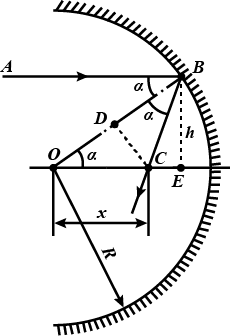
Two rays are incident on a spherical mirror of radius \[{\rm{R = 5cm}}\] parallel to its optical axis at distances \[{{\rm{h}}_1}{\rm{ = 0}}{\rm{.5cm}}\] and \[{{\rm{h}}_2}{\rm{ = 3cm}}\]. Determine the distance \[\Delta x\] between the points at which these rays intersect the optical axis after being reflected at the mirror.
Answer
218.7k+ views
Hint: The paraxial rays go through the region \[\dfrac{{\rm{R}}}{2}\] from the concave mirror's pole according to the query. Given that the marginal rays experience greater deviation than the paraxial rays, the solution to the aforementioned issue can be generated with ease. We shall therefore observe how the marginal and paraxial rays' positions with respect to the concave mirror's pole change as a result of the rays' deviation.
Complete answer:
Let \[{\rm{ABC}}\] be the ray incident at a distance \[{\rm{BE}}\] from the mirror axis, and let \[{\rm{O}}\] be the centre of the mirror's spherical surface.

The triangle \[{\rm{OBC}}\] is isosceles because according to the law of reflection \[\angle {\rm{ABO}} = \angle {\rm{OBC}}\] and \[\angle {\rm{BOC}} = \angle {\rm{ABO}}\] are alternate-interior angles, which can be seen from the right triangle \[{\rm{OBE}}\]. Hence, we have the triangle \[{\rm{ODC}}\] with \[{\rm{OD = DB = }}\dfrac{{\rm{R}}}{2}\].
Now from triangle ODC,
\[{\rm{x = }}\dfrac{R}{{2\cos \alpha }}{\rm{ = }}\dfrac{R^2}{{2\sqrt {{R^2} - {h^2}} }}\]
We know that the ray reflected by the mirror and the optical axis is said to be the point of intersection \[{\rm{C}}\].
The distance \[{{\rm{x}}_1} \approx \dfrac{{\rm{R}}}{2}\] with an error of about \[0.5\% \] since \[{{\rm{h}}_1}^2{\rm{ < < }}{{\rm{R}}^2}\] is for a ray propagating at a distance \[{{\rm{h}}_1}\]
Also, it is to be understand that, for a ray propagating at a distance \[{{\rm{h}}_2}\] the distance \[{{\rm{x}}_2} = 3.125\;{\rm{cm}}\]
From the previous calculations, finally, we obtain
\[\Delta {\rm{x}} = {{\rm{x}}_2} - {{\rm{x}}_1}\]
On substituting the value from the given data, we get
\[ \simeq 0.6\;{\rm{cm}}\]
Therefore, the distance \[\Delta x\] between the points at which these rays intersect the optical axis after being reflected at the mirror is \[0.6\;{\rm{cm}}\]
Note:It should be mentioned that this phenomenon is known as spherical aberration. The aperture of the spherical mirrors is the only thing that causes spherical aberration. The spherical mirrors will have the least spherical aberration if the aforementioned criteria are satisfied.
Complete answer:
Let \[{\rm{ABC}}\] be the ray incident at a distance \[{\rm{BE}}\] from the mirror axis, and let \[{\rm{O}}\] be the centre of the mirror's spherical surface.

The triangle \[{\rm{OBC}}\] is isosceles because according to the law of reflection \[\angle {\rm{ABO}} = \angle {\rm{OBC}}\] and \[\angle {\rm{BOC}} = \angle {\rm{ABO}}\] are alternate-interior angles, which can be seen from the right triangle \[{\rm{OBE}}\]. Hence, we have the triangle \[{\rm{ODC}}\] with \[{\rm{OD = DB = }}\dfrac{{\rm{R}}}{2}\].
Now from triangle ODC,
\[{\rm{x = }}\dfrac{R}{{2\cos \alpha }}{\rm{ = }}\dfrac{R^2}{{2\sqrt {{R^2} - {h^2}} }}\]
We know that the ray reflected by the mirror and the optical axis is said to be the point of intersection \[{\rm{C}}\].
The distance \[{{\rm{x}}_1} \approx \dfrac{{\rm{R}}}{2}\] with an error of about \[0.5\% \] since \[{{\rm{h}}_1}^2{\rm{ < < }}{{\rm{R}}^2}\] is for a ray propagating at a distance \[{{\rm{h}}_1}\]
Also, it is to be understand that, for a ray propagating at a distance \[{{\rm{h}}_2}\] the distance \[{{\rm{x}}_2} = 3.125\;{\rm{cm}}\]
From the previous calculations, finally, we obtain
\[\Delta {\rm{x}} = {{\rm{x}}_2} - {{\rm{x}}_1}\]
On substituting the value from the given data, we get
\[ \simeq 0.6\;{\rm{cm}}\]
Therefore, the distance \[\Delta x\] between the points at which these rays intersect the optical axis after being reflected at the mirror is \[0.6\;{\rm{cm}}\]
Note:It should be mentioned that this phenomenon is known as spherical aberration. The aperture of the spherical mirrors is the only thing that causes spherical aberration. The spherical mirrors will have the least spherical aberration if the aforementioned criteria are satisfied.
Recently Updated Pages
A square frame of side 10 cm and a long straight wire class 12 physics JEE_Main

The work done in slowly moving an electron of charge class 12 physics JEE_Main

Two identical charged spheres suspended from a common class 12 physics JEE_Main

According to Bohrs theory the timeaveraged magnetic class 12 physics JEE_Main

ill in the blanks Pure tungsten has A Low resistivity class 12 physics JEE_Main

The value of the resistor RS needed in the DC voltage class 12 physics JEE_Main

Trending doubts
JEE Main 2026: Application Form Open, Exam Dates, Syllabus, Eligibility & Question Papers

Derivation of Equation of Trajectory Explained for Students

Hybridisation in Chemistry – Concept, Types & Applications

Understanding the Angle of Deviation in a Prism

Understanding Collisions: Types and Examples for Students

Understanding Atomic Structure for Beginners

Other Pages
JEE Advanced Marks vs Ranks 2025: Understanding Category-wise Qualifying Marks and Previous Year Cut-offs

How to Convert a Galvanometer into an Ammeter or Voltmeter

Understanding Centrifugal Force in Physics

JEE Main Marking Scheme 2026- Paper-Wise Marks Distribution and Negative Marking Details

Degree of Dissociation: Meaning, Formula, Calculation & Uses

Understanding Electromagnetic Waves and Their Importance




